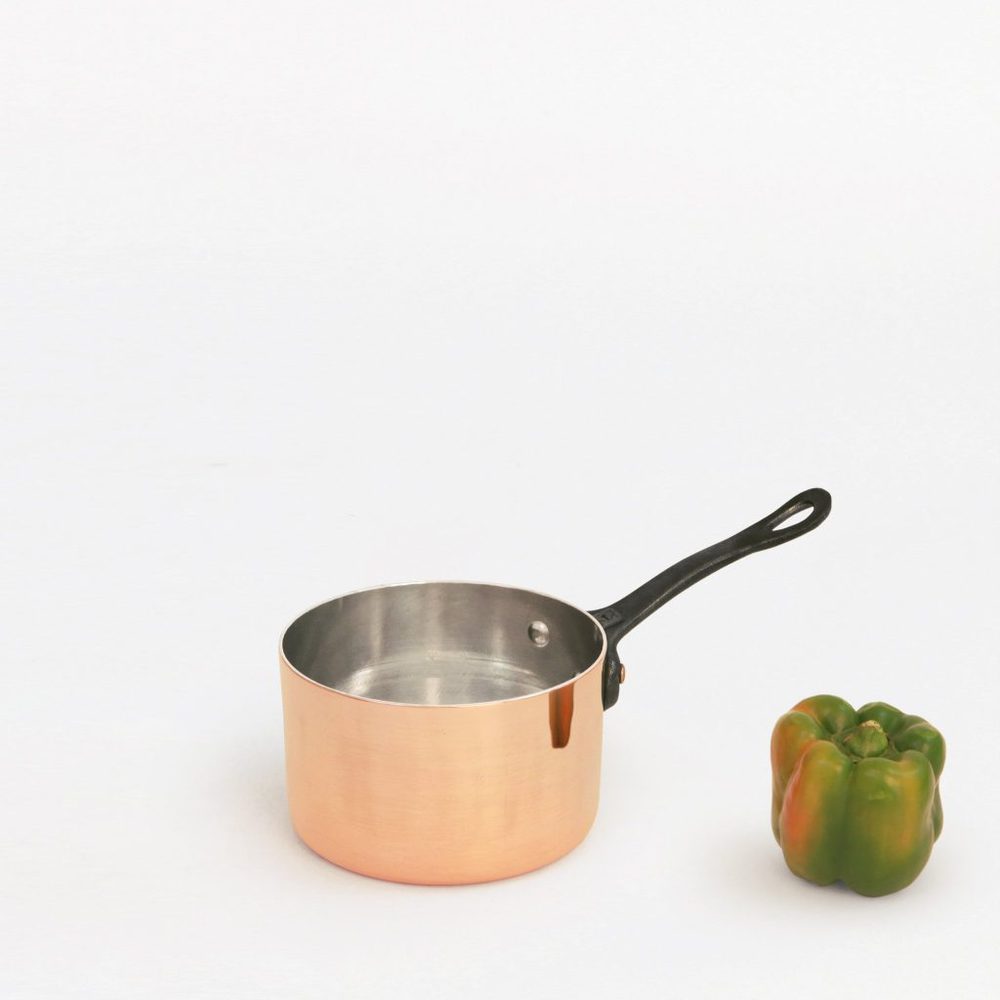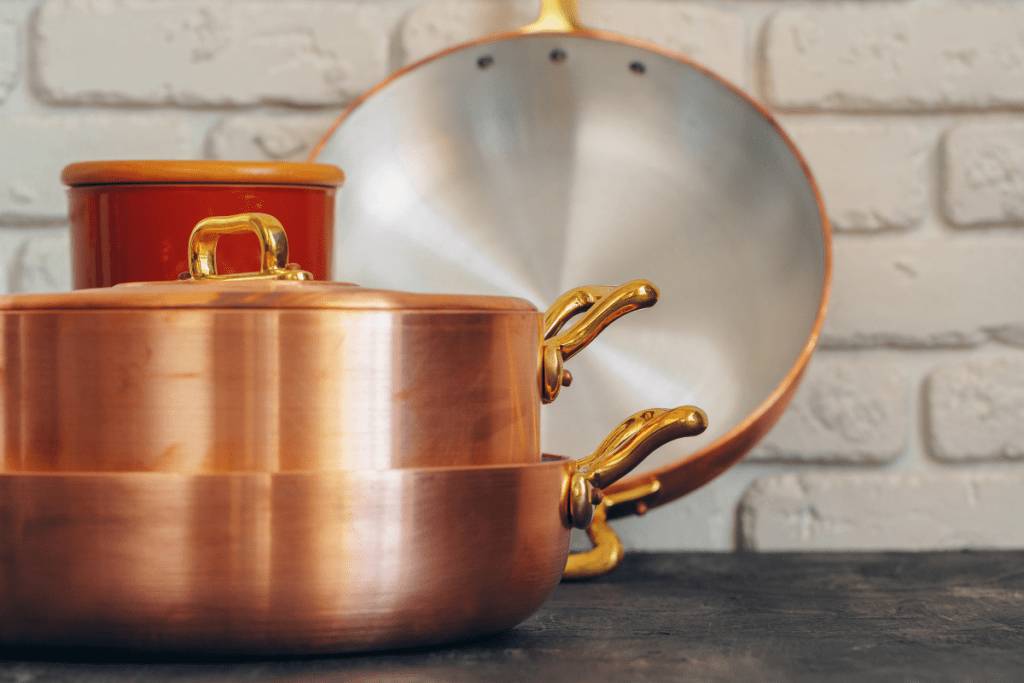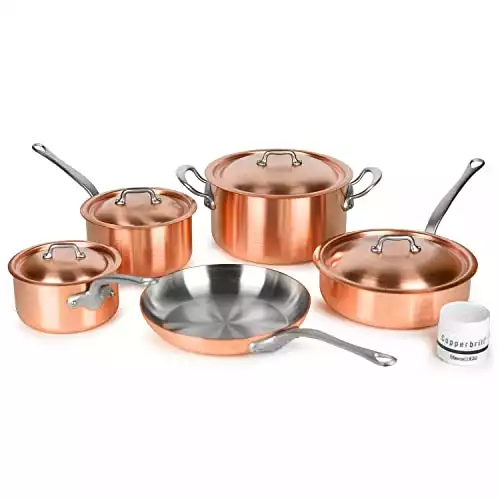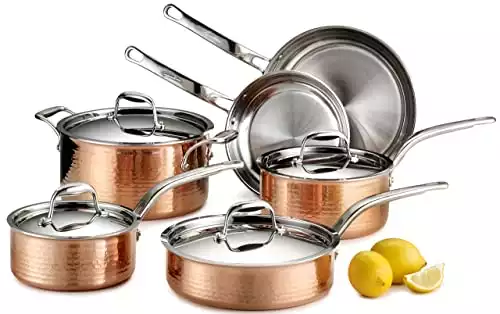Paying hundreds or even thousands on copper cookware is a big investment, so it’s important to know what you’re looking for before shopping.
I’ve had the privilege of cooking with copper in several professional kitchens. In this article, I’ll share those experiences with you to help make sense of which features are important and which aren’t, so you can get started cooking with the pinnacle of cookware materials.
My hope is that this simple primer will go a long way toward helping you find the best copper cookware for your kitchen.
In This Article
Our Top Picks
- Excellent build quality and materials
- 90% copper construction means superb heat distribution
- Stainless steel lining is durable and safe for all ingredients
- Inexpensive for copper cookware
- Well made, fully clad pots and pans should last a lifetime
Best Overall: Mauviel M’heritage Brushed Copper Cookware
I’ve used this collection extensively in a professional setting and found that they outperform just about any cookware on the market. They are a joy to use in a fast-paced restaurant but the quick and even heating is just as useful in a home kitchen.
These pots and pots don’t just come with a skimpy layer of copper that will peel or flake off over time. Each piece in the collection is made from 90% copper and 10% stainless steel. That translates to a 2.5-millimeter thick copper body and a very thin stainless steel interior layer.
The reason such a high percentage of copper is important is that it is the most conductive cookware material available.
When cooking with copper, your pans will heat up exceptionally fast and the heat will be distributed evenly from base to rim. If you need to adjust your cooking temperature, copper cookware will also react and change faster than anything else.
The downside of copper is that it is very reactive, especially to acidic ingredients. Mauviel has solved the problem by adding a thin but durable stainless steel cooking surface.
The lining adds durability and allows you to use any ingredient without worrying about copper leaching. Mauviel has also kept the stainless steel thin enough that it won’t interfere too much with copper’s superior conductivity.
The handles are solid stainless steel and are designed to stay cool, but they tend to get quite warm during stovetop use. The lids are also copper with a stainless steel interior and handle.
Each piece is oven-safe all the way up to 680 F, which is hotter than most home ovens can get.
This cookware is not dishwasher safe and must always be hand washed. As a nice bonus, many of the Mauviel copper cookware sets include a container of their own copper cleaner.
Since copper is not magnetic, you cannot use this cookware on an induction stove, but all other cooktops are fair game.
Mauviel has been making copper cookware since the 1830s and their pots and pans are as functional as they are beautiful. While the price may seem steep compared to other materials, you’d be hard-pressed to find cookware of this quality for any less.
What we like
- Excellent build quality and materials
- 90% copper construction means superb heat distribution
- Stainless steel lining is durable and safe for all ingredients
What We don’t
- High price tag
- Handles can get hot during stovetop use
Best Affordable Option: Lagostina Hammered Copper Cookware
If you want the look and some of the benefits of copper cookware at a more reasonable price, Lagostina Martellata is a great option to consider.
Don’t get me wrong, these aren’t cheap by any means. But Lagostina’s tri-ply copper cookware takes advantage of an aluminum core for solid conductivity and big cost savings.
The exterior is a beautiful hammered copper and the interior is durable stainless steel. Between that is a thick aluminum core. Aluminum conducts heat very well, second only to copper but at a fraction of the cost.
The copper layer is quite thin but it will still help to distribute heat quickly and evenly throughout the cookware.
The lids do not feature any copper but are made entirely from stainless steel. This is another step that helps bring down the price without sacrificing performance.
The lids add a nice contrasting look to the copper and also match the cast stainless steel handles.
This is the only cookware set in our top three that has flared rims on every piece. That’s a useful feature that makes pouring liquids easy and mess-free.
As with our other picks, this collection is not induction compatible and cannot be used in a dishwasher, but it is oven safe up to 500 F.
While all copper is prone to tarnishing, several owners found that this Lagostina line suffered from discoloration easier and more often than our other top picks.
Compared to our Best and Upgrade options, this line does not provide the same level of heat distribution. It’s also not nearly as responsive to temperature changes. But at less than a third of the price, Lagostina is the best way to get high-performing copper cookware on a budget.
What we like
- Inexpensive for copper cookware
- Well made, fully clad pots and pans should last a lifetime
What We don’t
- The copper exterior is thin and discolors easily
- The aluminum core does not distribute heat as evenly as copper
Best Upgrade Option: Brooklyn Copper Cookware

For the absolute best, highest performing, and most expensive copper cookware, Brooklyn Copper is the way to go.
Each of their pieces are handmade and will give you the most precise temperature control and best heating conductivity around. All of their cookware is made from just three pure materials. Copper, cast iron and tin.
The smaller pieces like the one and two quart saucepans are made from 2.5-millimiter thick copper. The larger options like rondeaus, saute pans, and casseroles are a bit thicker at 3-millimeters.
The substantial amount of copper heats quickly and evenly from base to rim, helping ingredients cook at the same rate. Copper also transfers heat so efficiently that you can accomplish just about any cooking task over a low to medium heat, without any preheating time.
The tin lined copper is more traditional than a stainless steel lining and offers much better non stick properties. On the downside, tin lined copper is not quite as durable. Because of this, you should avoid using metal utensils and stick to wood or silicone.
Tin also has a relatively low melting point, around 425 F. Because of this, you should never heat an empty Brooklyn Copper pot. Always add enough liquid or fat to cover the bottom of the pot or pan before turning on the stove.
Brooklyn Copper is oven safe but must be kept below tin’s 425 F melting point, and broiling should always be avoided.
I know it can sound like this highly expensive cookware must be treated like a baby, but the copper itself is very durable and will last lifetimes. If your tin lining is damaged, it can always be re-tinned for a reasonable price.
The handle on every piece is copper-riveted and made from cast iron with a light wax coating to prevent rust. The lids are made from 1.5-millimeter thick copper and lay completely flat. They also have cast iron handles, and a tin lining.
As you might expect, these pieces are not dishwasher safe and cannot be used on an induction cooktop.
Each piece is different, but here’s an idea of what you might expect to pay for Brooklyn Copper Cookware. Their smallest 1-quart sauce pan is around $200 and the large 14-quart stockpot is over $1000.
Building an entire collection will probably always remain a dream for many of us. But, adding one or two pieces might be possible and will give you instant street cred with your local chefs.
What we like
- The best and most even heat distribution available
- Every piece is painstakingly hand made to the highest standards
What We don’t
- Extremely expensive
- Tin has special requirements and will eventually need to be re-tinned
Other Options That Are Great But Didn’t Make The Cut
When it comes to copper cookware, there aren’t as many options as with stainless steel or aluminum. Our top three choices are all tried and proven options that meet the needs of a wide range of cooks.
Even with fewer choices, there are a number of other brands making high quality copper pots and pans that could meet your needs better than our top picks.
Matfer Bourgeat Copper Cookware
Matfer Bourgeat is a French cookware manufacturer that’s been around for more than 200 years. They certainly know what they’re doing and they make very fine, professional-level cookware.
Matfer Bourgeat’s copper cookware is very similar to Mauviel, our top pick. They are made from 2.5-millimeter thick copper with a thin stainless steel interior. The lids are also copper with a stainless steel lining, and the handles are similarly designed.
The only major difference is that the handles are cast iron rather than stainless steel. These tend to get very hot during stovetop use, but are very sturdy and feel good in the hand.
It would be difficult for anyone to tell the difference in cooking performance between these and Mauviel. So, Since Matfer Bourgeat pans are more expensive they didn’t take the top spot.
Calphalon T10 Tri-Ply Copper Cookware
It seems like it’s impossible to make a best cookware list without at least mentioning Calphalon. They’re known to make high-end cookware at reasonable prices, and they have an option in just about every cookware category.
Their tri-ply copper cookware has a lot of similarities to Lagostina Martellata, which ultimately won out. Calphalon uses a stainless steel cooking surface for durability and ease of use, a thick aluminum core, and a thin copper exterior.
From a performance standpoint, it would be hard to tell the difference between the two. The reason Calphalon didn’t make our top three is that more owners had issues with discoloration and imperfections, and at a slightly higher price to boot.
Plus, it’s hard to deny how good Lagostina’s hammered copper looks.
All-Clad Copper Core Cookware
This is a five-layer, fully clad copper option that is very low maintenance. You may notice right off the bat that this cookware collection looks more like stainless steel cookware than anything else. The only clue that this is copper cookware is the exposed ring of copper around the lower portion of the pots and pans.
Rather than an exterior layer, All-Clad uses an internal copper core surrounded by two layers of aluminum and two layers of stainless steel.
The result is cookware that performs more like the highest-end stainless steel than solid copper. The internal copper layer offers slightly improved heat distribution, but it’s barely noticeable compared to their less expensive stainless steel options.
If you’re going to go with All-Clad, I would stick to the D3 and D5 collections that offer similar performance at a lower cost.
Buyers Guide: Picking The Best Copper Cookware

Greatest Benefits Of Owning Copper Cookware
Copper offers two big benefits that can’t be matched by any other cooking material. One, is that it looks absolutely stunning.
We’re so used to silver and black pots and pans that the brilliance of copper immediately catches the eye, and will elevate the look of any kitchen.
That has nothing to do with cooking performance, but it’s like buying art that has real functional value. And who knows, maybe it will make you want to spend more time cooking.
Without getting too sciency, the real cooking benefit has to do with thermal efficiency. When it comes to cookware, that’s just how easily heat is transferred from stove, to pan, to food.
Copper is 25 times more thermally efficient than stainless steel. Since it has such good thermal conductivity, you can use lower heat than you would with stainless steel. Copper also heats evenly and gives you better temperature control.
Not only will that make cooking faster, but you can even save a little money on your gas or electric bill.
Common Drawbacks Of Owning Copper Cookware
The first and most obvious drawback of copper is that it is very expensive compared to other cookware materials. But once you get over that hurdle, a good sauté pan or a whole copper set will give you a lifetime of use.
The next thing to keep in mind is that solid copper cookware is not dishwasher safe and cannot be used with induction cooktops. But, Handwashing is very easy and straightforward, and polishing can be done with just one or two household ingredients.
If you choose copper that is lined with tin, that adds an extra level of care that you’ll have to keep in mind.
Copper Cookware Construction and Materials
There are a few different ways that copper is used in cookware. All of them aim to take advantage of the excellent heat conductivity.
The most inexpensive construction method is copper bottom pans. This is simply a disk of copper that is bonded within the base of stainless steel or aluminum cookware.
This can provide more even heating in the bottom of this type of cookware. But, it is often an extremely thin layer of copper and is usually reserved for entry level, and very budget friendly options.
Fully clad copper cookware is a high quality option that can be quite expensive, but still more affordable than the solid copper options.
Lagostina Tri-Ply and All-Clad Copper Core are good examples of fully clad copperware, in two very different packages.
Lagostina has a copper layer on the exterior, while All-Clad has a copper core. With either option, multiple layers of metal are sandwiched together from base to rim. This gives excellent heat distribution throughout the entire pot or pan.
If you’re cooking with copper bottom or clad cookware, it’s likely that the benefits will be subtle and hard to really notice.
The last and most expensive method is solid copper cookware. This style is made almost entirely of copper, with a very thin layer of tin or stainless steel covering the cooking surface. Our top and upgrade picks are a perfect example of each.
High end, solid copper cookware delivers the highest performance. Preheating times are eliminated, and you’ll never have to deal with hot spots again.
What To Look For When Buying Copper Cookware
Once you’ve decided between solid or clad copper cookware, you’ll have a couple more things to take into consideration.
If you go with the clad option, you can decide between a copper exterior or copper core. A copper exterior looks beautiful, just like solid copper cookware. It also means that special attention is required when it comes to cleaning, and it cannot be used with induction cooktops.
An option like All-Clad Copper Core looks more like regular stainless steel with only a small band of visible copper. The good thing about this option is that it is very low maintenance and it is induction compatible.
For the solid copper option you’ll want to look at the thickness of the copper as well as the lining material.
When it comes to thickness, you want a copper layer that is between 1.75 and 3-millimeters thick. That window gives the best heat distribution and is still very responsive to temperature changes.
Once you start going over 3-millimeters you begin to lose the responsiveness and quick heat up times of copper. On the other end, if copper is too thin it will be less durable and won’t distribute heat as well.
The most common lining options are tin or stainless steel. Tin is more traditional and gives the best cooking experience when it comes to fast and even heating. On top of that, tin has natural nonstick properties.
All of that is great, but it’s also not incredibly durable, and the tin lining will eventually need to be replaced.
Stainless steel is a great choice for low maintenance and durability. The downside is that stainless steel is not naturally nonstick and will slightly reduce the heating benefits of copper.
How Durable Is Copper Cookware?
Copper itself is very durable and will last a lifetime, especially if you choose cookware that falls in the preferred range of 1.75 and 3-millimeters thick.
Durability issues usually come down to copper cookware that is lined with tin. Tin provides an excellent cooking experience, but it’s a relatively soft metal with a low melting point.
Tin linings can easily be scratched by metal utensils, and a server scratch would require a new tin lining, known as retinning.
If tin is brought to temperatures around 425 F or above it will start to melt and blister. To avoid this, never heat a dry pan and avoid high-temperature oven use. If blistering does occur, the cookware will also need to be retinned.
Getting your cookware retinned does mean your pots and pans will be out of commission for a while, but the price is relatively affordable.
What Maintenance Is Required With Copper Cookware?
Cleaning and maintaining your copper cookware is quite simple and only takes a little extra effort.
Soapy water and soft sponge or brush are all you need for most cleanups. Always avoid using abrasive cleaners. This is especially important if you have tin lined copper as tin is especially susceptible to scratching.
Cleaning copper while it is still warm (not hot), is a good practice to adopt and will make your life easier. After cleaning, dry your cookware by hand rather than allowing it to drip-dry. Water that is left to air-dry will leave very visible water spots.
Aside from cleaning after each use, you may want to polish the copper to keep it bright and shiny. Products like Wright’s Copper Cream clean and polish at the same time, and are very easy to use.
A great alternative to buying an additional cleaner is to use acid and salt. Lemon juice or white vinegar both work great and are readily available in most kitchens.
Simply take a half a lemon, dip it in kosher salt and rub it all over any exposed copper. Follow that with a soapy wash, rinse, and dry and you’re all set.
Brooklyn Copper has another interesting cleaning method using a mixture of two-parts ketchup and one-part kosher salt. The paste is rubbed over the copper surface, left for 2-3 minutes, then cleaned like normal.
Whether you use lemon juice, ketchup, or a dedicated cleaner, copper cookware doesn’t take much to keep looking it’s best. But whatever you do, don’t run your copper through the dishwasher and never use bleach. Either one of those will lead to pitting and corrosion.
Is Copper Cookware Safe To Use?
Copper itself is highly reactive and can easily leach into foods. Luckily almost all copper cookware made today is lined with a food safe coating, usually stainless steel or tin.
Lined copper gives you most of the heating benefits, without any health risks to worry about.
You can still find pure copper cookware that is unlined for specific cooking tasks. Pure copper is often preferred for candy making, since very precise temperatures play an important role.
How Expensive Is Copper Cookware?
Copper is more expensive than any other cookware material. This is true for the simple reason that copper as a pure element is very expensive.
The more copper used, the more you can expect to spend. This is easy to see when you look at the price and construction of our Mauviel pick compared to Lagostina.
Mauviel is made almost entirely from copper and the high price reflects that. The hammered copper exterior of Lagostina is beautiful, and looks very expensive, but it’s a thin layer and so the price is more affordable.
If you come across a frying pan or maybe a stock pot that looks like copper but only costs around $20, be sure to take a close look before buying. There may even be copper in the name, Copper CHef for instance.
There is a whole category of cookware that uses some form of copper in their nonstick coating. You can almost always count on this as being no more than a marketing gimmick to advertise better heat distribution.
Those options may be great as a cheap non stick pan, but they should not be compared to real copper cookware in any way.
Can I Use Copper Cookware On Any Cooktop?
Cookware that has copper on the exterior can be used on any type of cooktop except for induction. In order to get around that, you can purchase induction adapters but results can be inconsistent.
If you choose an option like All-Clad Copper Core, you can use any type of cooktop. This includes induction because the exterior layer of stainless steel is magnetic.
What Copper Cookware Pieces Should I Own?
Since the best copper cookware can be incredibly expensive, it often makes the most sense to purchase one or two pieces individually. Choosing which pieces may be different for each person, but I think these are the best choices that provide the widest range of uses.
A 2-quart saucepan is a very versatile pot and it’s one that gets used for most meals in my home. It’s ideal for any kind of sauce and is perfect for rice or any other grain for up to four people.
If you regularly cook for a large number of people, consider jumping up to a 3 or even 6-quart saucepan.
Another very useful piece is a copper frying pan. The even and precise heating is great for delicate foods or things like pancakes or crepes. You’ll never have to worry about uneven cooking and things will always come out very uniformly cooked and browned.
A unique item that you definitely don’t need, but I know I want, is a copper egg white bowl. This is an unlined bowl that allows the copper to react with egg whites for the fluffiest and most stable souffles, cakes, and merengues.
The Do’s And Don’ts Of Copper Cookware
Copper cookware may seem like it comes with a long list of rules to follow or your cookware will be ruined. But sticking to some simple guidelines will keep your cookware functioning at its best, and will become second nature in no time.
Do:
- Use low and medium heat
- Have all your ingredients ready to go before you start cooking
- Use wood and silicone utensils in tin lined copper
- Hand wash and dry
Don’t:
- Preheat copper cookware
- Heat a dry pan
- Use metal utensils in tin lined copper
- Use the dishwasher or bleach
Our Recommendation
If money was of no consequence I would buy a full set of Brooklyn Copper Cookware. Each piece is beautiful and will provide the best copper cooking experience. Since that’s not the case for me, I would consider adding their 2-quart saucepan to any cookware collection.
Mauviel is an excellent pick for cookware that can take a bit more abuse and requires less special care. It will still give you most of the copper’s heating benefits in a more durable package.
Our most affordable pick is a solid option if you want the look of copper cookware. But when it comes to heating and cooking performance, Lagostina functions more like stainless steel than true copper cookware.
For a better idea of how copper compares to other options, check out our guide to the best cookware materials.











